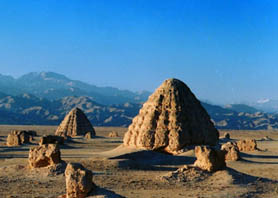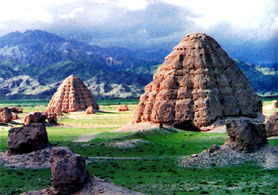The mausoleum is one of the largest and best preserved imperial graveyards in China. It is located at the eastern foot of Helan Mountain, measuring 10 kilometers from north to south, 4 kilometers from  east to west. The Mausoleum contains eight tumuli and over 70 annex tombs. The tumulus each has an independent group. Encircled by a wall with an entrance gate in each direction, it has four corner towers and an array of watchtowers, pavilions housing stone tablets, external city, sacrificial hall and coffin platform from south to north. east to west. The Mausoleum contains eight tumuli and over 70 annex tombs. The tumulus each has an independent group. Encircled by a wall with an entrance gate in each direction, it has four corner towers and an array of watchtowers, pavilions housing stone tablets, external city, sacrificial hall and coffin platform from south to north.
It passes more than 100 thousand square meters. They are tombs of 193 high officials, generals and aristocrats of the ancient kingdom of Western Xia. It is largest and unique not only in structure but also in their sheer sizes and close proximity to each other. A seven-layered solid pagoda 22 meters in height and octagonal in shape, with each side measuring 12 meters in length, is positioned 10 meters west of the vertical line of each mausoleum, which is also graced with two to three stele pavilions. The boundaries of each mausoleum are marked with four corner turrets, a unique feature of Western Xia mausoleums. The companion tombs are in cylindrical, truncated cones, vaulted and other designs.
The tumulus excavated in 1972 has an underground sloping passage, 49 meters long, leading to a  square coffin chamber. There's a supplementary pit dug into earth 25 meters deep, at each side of the chamber. Despite a previous excavation, the unearthed were still a variety of burial objects: gold ornaments, gilded or silver jewelry, bamboo carvings, copper armor-plates, pearls, broken porcelains etc. Each of the three annex tombs that are already dug has a stairway or sloping path to coffin pit. The usual funerary objects in the earth square pits were copper ox and stone horses. Things left about the ground buildings in the tumuli, which were dug or destroyed before the Ming Dynasty is only a ruin nowadays. However, a great amount of building materials and broken stone tablets and steles with inscriptions in Western Xia or the Han characters still remain. The tumuli imitated the style of tombs in the Tang Dynasty or the Northern Song Dynasty, and are reputed as "Chinese Pyramid". square coffin chamber. There's a supplementary pit dug into earth 25 meters deep, at each side of the chamber. Despite a previous excavation, the unearthed were still a variety of burial objects: gold ornaments, gilded or silver jewelry, bamboo carvings, copper armor-plates, pearls, broken porcelains etc. Each of the three annex tombs that are already dug has a stairway or sloping path to coffin pit. The usual funerary objects in the earth square pits were copper ox and stone horses. Things left about the ground buildings in the tumuli, which were dug or destroyed before the Ming Dynasty is only a ruin nowadays. However, a great amount of building materials and broken stone tablets and steles with inscriptions in Western Xia or the Han characters still remain. The tumuli imitated the style of tombs in the Tang Dynasty or the Northern Song Dynasty, and are reputed as "Chinese Pyramid".
|
